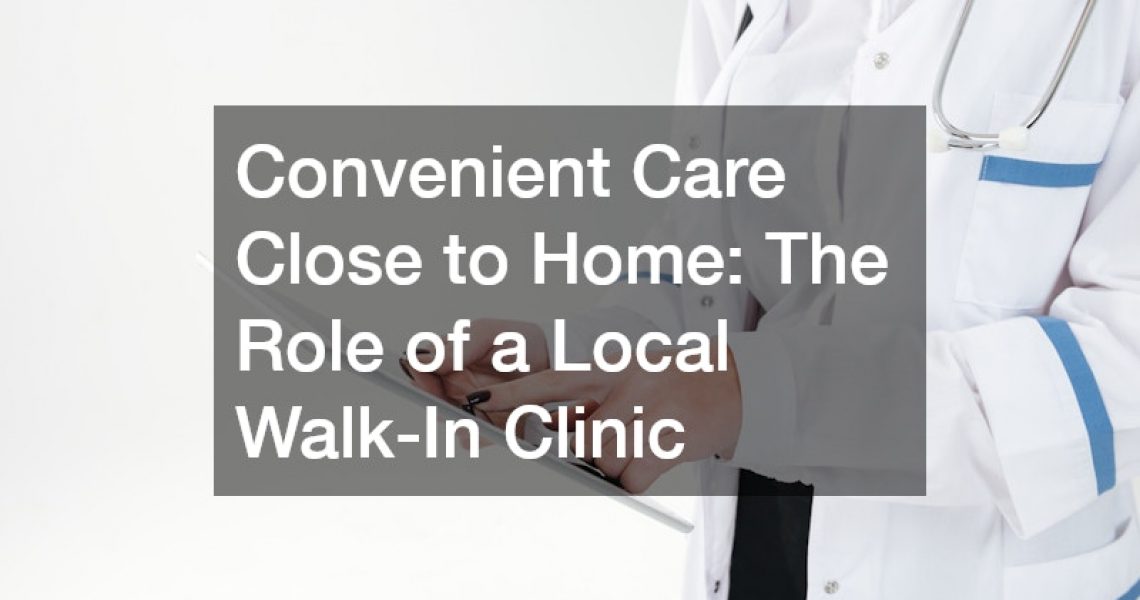When unexpected health concerns arise, people often find themselves searching for care that is quick, reliable, and close to home. A local walk-in clinic has become a trusted option for individuals and families who need immediate medical attention without the need for a prior appointment. These clinics bridge the gap between traditional primary care and emergency rooms, offering convenience and quality care in the community.
Accessibility for Everyday Needs
One of the greatest strengths of a local walk in clinic is its accessibility. Life is unpredictable—illnesses and minor injuries rarely happen on schedule.
Instead of waiting days for a primary care appointment or spending long hours in an emergency room for non-life-threatening conditions, patients can simply walk in and receive timely care. This accessibility allows people to address their health concerns before they escalate into more serious issues.
For families, this ease of access is particularly important. Parents with young children know that sudden fevers, earaches, or minor injuries can happen at any time. Having a clinic nearby ensures that children receive medical attention promptly, easing concerns for caregivers. Similarly, adults juggling work, school, and family responsibilities benefit from the flexibility these clinics provide.
A Wide Range of Services
Local walk-in clinics are designed to treat a broad spectrum of health concerns. From colds, flu, and sore throats to sprains, cuts, and minor burns, the care team can handle many urgent but non-emergency needs. Many clinics also offer routine services such as vaccinations, physical exams, and screenings, further supporting community health.
Because of this range, patients often turn to walk-in clinics not only for urgent conditions but also for preventive care. Having access to immunizations or health check-ups in a convenient setting encourages more people to stay proactive about their wellness.
Bridging Primary and Emergency Care
A local walk-in clinic fills an important role between the family doctor’s office and the emergency room. For conditions that are not life-threatening but still require timely attention, these clinics are a practical alternative. They are staffed by qualified healthcare professionals who can assess symptoms, recommend treatments, and even refer patients for specialized care when necessary.
This middle ground is vital for both patients and healthcare systems. By managing common illnesses and injuries, walk-in clinics reduce the strain on emergency departments, ensuring that hospitals can focus on more critical cases. At the same time, they complement primary care providers by offering extended hours or quick services when scheduling with a doctor is not possible.
Building Trust in the Community
Beyond medical treatment, local walk-in clinics contribute to the health and well-being of their communities by building trust. They are often neighborhood-based, meaning patients are likely to see the same clinicians over time. This familiarity fosters comfort and confidence, especially for those who might otherwise hesitate to seek care.
Community-focused healthcare settings also encourage a more personal approach. Staff often understand the unique needs of the local population and tailor services accordingly. This sense of connection enhances the patient experience and reinforces the idea that quality care is accessible right in the neighborhood.
Support for Busy Lifestyles
Modern life is fast-paced, and scheduling can be a challenge. Many people delay addressing health concerns because they cannot find the time to make an appointment or wait for one. A local walk-in clinic helps overcome this barrier by allowing patients to seek care when it fits into their schedule.
Extended hours, including evenings and weekends, make these clinics especially valuable for workers, students, and parents who may not be able to take time off during traditional office hours. This flexibility ensures that healthcare does not become a burden or an afterthought, but an accessible part of daily life.
Encouraging Preventive Health Habits
While walk-in clinics are best known for treating urgent needs, they also play a role in promoting preventive health habits. With routine services such as physical exams and immunizations, patients are encouraged to keep up with their health rather than only seeking care when something goes wrong.
Preventive care reduces the risk of more serious conditions developing later on. By making these services easy to access, clinics empower patients to take responsibility for their long-term health. This proactive approach benefits individuals and communities alike, contributing to overall wellness.
The Future of Convenient Care
As healthcare continues to evolve, local walk-in clinics are likely to remain a key resource for communities. Their ability to adapt to patient needs, provide immediate care, and offer a welcoming environment positions them as an essential part of modern healthcare.
With technology integration, some clinics are also expanding into telehealth, allowing patients to consult with providers virtually for certain conditions. This combination of in-person and digital care ensures that healthcare remains flexible and responsive to changing lifestyles.
A local walk-in clinic is more than just a convenient stop for minor health concerns—it is a cornerstone of community healthcare. By offering timely, accessible, and reliable services, these clinics give individuals and families the confidence that help is available when they need it most. From urgent needs to preventive care, they provide a bridge between traditional doctor visits and emergency services, ensuring that quality care is always within reach.


